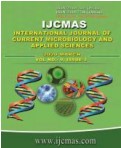


 National Academy of Agricultural Sciences (NAAS)
National Academy of Agricultural Sciences (NAAS)

|
PRINT ISSN : 2319-7692
Online ISSN : 2319-7706 Issues : 12 per year Publisher : Excellent Publishers Email : editorijcmas@gmail.com / submit@ijcmas.com Editor-in-chief: Dr.M.Prakash Index Copernicus ICV 2018: 95.39 NAAS RATING 2020: 5.38 |
Groundwater is one of the crucial natural resources which meets the requirement of drinking as well as for irrigation. Increasing population, erratic distribution of rainfall and their rising demand for water in domestic and irrigation is fulfilled by groundwater resources. Hence, a geo-spatial study was conducted for groundwater sampling for water quality assessment to determine the suitability of water for drinking and irrigation purpose. For this study, five villages around AEC & RI, Kumulur, Trichy, Tamil Nadu were selected as a study area with an aerial extent of 45.1 km2. For the assessment of groundwater quality, samples from 53 locations were collected from sources like open well, bore well and hand pump. The parameters viz. pH, electrical conductivity, Anions (Chlorides, Carbonates, Bi-carbonates, Sulphates) and Cations (Calcium, Magnesium, Sodium, Potassium, Boron) were estimated using the standard analytical procedure. The different physico-chemical data of above analysis were used for the computation of three Water Quality Index (WQI) for drinking (WQI1 & WQI2) and irrigation (WQI3) needs. The WQI variability thematic maps were generated in ArcGIS software using spatial interpolation technique, which provides a detailed overview of water quality status across the study area. The WQI1 and WQI2 show that water quality of the study area is far lower than the permissible limits which conclude the suitability of water for drinking. In WQI3, 96% samples fall under the permissible category and 4% samples i.e. 0.44 km2 area, fall under the very poor and unsuitable category, which needs treatment before usage for irrigation.
 |
 |
 |
 |
 |